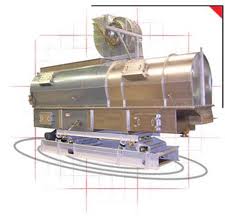Difference between revisions of "Fluid Bed Coolers"
(Created page with "Category:Cooling{{Knoppen}} <noinclude><!------------------------------------------------ * READ THIS FIRST * Only edit this page if you can improve the content. * Improper ...") |
|||
| (2 intermediate revisions by the same user not shown) | |||
| Line 6: | Line 6: | ||
* Please do not edit the sponsored link on the top right corner. | * Please do not edit the sponsored link on the top right corner. | ||
* Please start editing this page after the /noinclude | * Please start editing this page after the /noinclude | ||
* -------------------------------------------------></noinclude> | *-------------------------------------------------></noinclude> | ||
[[File:Fluid bed cooler.jpg|thumb|right|Fluid Bed Coolers]] | |||
[[File:Open circuit fluid bed cooler.gif|thumb|right|Open circuit Fluid Bed Cooler]] | |||
'''Fluid Bed Cooler''' technology is used for cooling, heating and drying of bulk solids materials. Fluid bed heat exchange takes place by passing a gas (most commonly air) through a perforated distributor plate which then flows through a layer (bed) of solids. The air performs two functions. First, the air flows through the bed of solids at a velocity sufficient to support the weight of the particles, which creates a fluidized state enabling the particles to flow. Second, the air in the fluid bed serves to cool, heat or dry the particles as it comes into direct contact with the solids material within the fluid bed chamber. | |||
The premise behind fluid bed technology for cooling and heating is that large volumes of air are used to both fluidize the material (required to enable the product to flow) and to act as the heat exchange medium – adding or removing heat from the process. | |||
With fluid bed coolers, ambient air is taken in using large fans and, in most climates, the air must be chilled (or treated) before being blown across the product using large horsepower fans. The air leaving the fluid bed cooler is then discharged through an emissions stack. Both the chilling process and the circulating fans have high energy requirements. | |||
Latest revision as of 01:11, 4 August 2012
Fluid Bed Cooler technology is used for cooling, heating and drying of bulk solids materials. Fluid bed heat exchange takes place by passing a gas (most commonly air) through a perforated distributor plate which then flows through a layer (bed) of solids. The air performs two functions. First, the air flows through the bed of solids at a velocity sufficient to support the weight of the particles, which creates a fluidized state enabling the particles to flow. Second, the air in the fluid bed serves to cool, heat or dry the particles as it comes into direct contact with the solids material within the fluid bed chamber.
The premise behind fluid bed technology for cooling and heating is that large volumes of air are used to both fluidize the material (required to enable the product to flow) and to act as the heat exchange medium – adding or removing heat from the process.
With fluid bed coolers, ambient air is taken in using large fans and, in most climates, the air must be chilled (or treated) before being blown across the product using large horsepower fans. The air leaving the fluid bed cooler is then discharged through an emissions stack. Both the chilling process and the circulating fans have high energy requirements.

